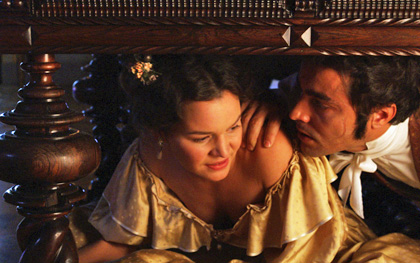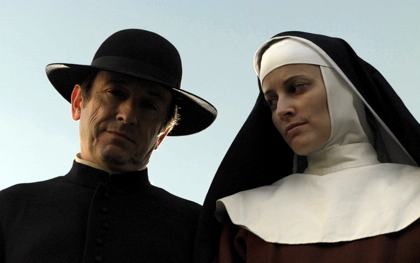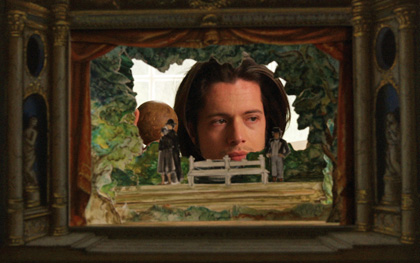Primary navigation


Raúl Ruiz, who died in August, has left behind a magisterial four-hour saga set in 19th-century Portugal that serves as a fittingly elegant summation of his life’s work. Jonathan Romney explores the Mysteries of Lisbon
The dominant mystery in Raúl Ruiz’s Mysteries of Lisbon (Místerios de Lisboa) is that there is no mystery: everything is explained, sooner or later. No sooner does the narrator João raise the question of his parentage than we discover his mother’s identity; the story of his father follows closely. Nothing is withheld for long; you might call this a story of transparency, in which all truths are eventually available to the eye of knowledge. Hence the overtly voyeuristic staging of one bedroom tryst, with heavy curtains ostentatiously pulled aside to frame the action for our benefit.
Based on a novel by the prolific Portuguese writer Camilo Castelo Branco (1825-1890), Ruiz’s chamber epic follows a topos of 19th-century fiction, according to which all things are knowable – at once by the author, the narrator and (implicitly or otherwise) God, represented here by the omniscient, omnipresent, protean Father Dinis.
Scripted by Carlos Saboga, Mysteries of Lisbon might at first appear unusually sober by Ruiz standards. It’s Viscontian in its austere elegance; the sumptuously staged period action is often executed in flamboyantly extended single takes – characteristically in elegantly gliding shots, as if the camera were executing a stately dance around the characters. Gorgeously photographed (digitally) by André Szankowski, the film frequently fixes its actors in compositions that resemble tableaux vivants, modelled variously on salon paintings of the era and Spanish Golden Age interiors.
Mysteries fulfils all the requirements of the European prestige costume drama, and exists in two forms – as the 266-minute theatrical release, and as a TV series in six one-hour episodes. By all accounts Ruíz, who died in August 2011, preferred the cinema cut, perhaps rightly: the abridged Mysteries has a self-contained concision (all things being relative) that allows its themes to resound with each other, as in a sealed echo chamber.

Without having read him, one suspects that Castelo Branco might be ranked among the most obscure major writers of his century (Manoel de Oliveira adapted his Doomed Love and based Day of Despair on his death). One guesses that Castelo Branco was a candidly derivative writer, for Mysteries of Lisbon, written in 1854, clearly owes much to Balzac and to the prolific French serial writer Eugène Sue, author of the similarly involved Mysteries of Paris (1842-3).
Particularly characteristic of such fiction is the theme of permanent social flux. Characters rise and fall dramatically, and sometimes change identity altogether. The story hangs between two shapeshifters – Father Dinis and Antonio de Magalhães – who are at once doubles and polar opposites, divine and satanic presences, both of them surrogate fathers to João. Magalhães, a criminal benefactor à la Magwitch, finances the young man thanks to the money paid by Dinis for sparing his life. The same money allowed Magalhães (the erstwhile thug ‘Knife-Eater’) to reinvent himself as a Byronic corsair and society firebrand. He embodies the story’s social critique, revealing that between a lowly cutthroat and a society buck, there may be very little moral difference.
Magalhães’s counterpart is Father Dinis: priest, spy, puppeteer, master of disguise – and in more ways than one, servant of God, the course of the narrative seemingly being Dinis’s manipulation in the name of divine providence. Dinis represents the holy side of that quintessential 19th-century figure, the endlessly mobile social manipulator – the underground Napoleon; in Balzac, this figure is played by the criminal Vautrin, one of whose alter egos is a priest.
Dinis may be an angelic Vautrin, but he has a sinister aura, as incarnated by the saturnine, self-effacingly mischievous Adriano Luz. A shadowy presence, he glides in and out of the action, appearing and disappearing through overt tricks of camera movement – at one point vanishing during a single shot, leaving only his hat and cloak behind. His multiplicity is revealed in an extraordinary scene in which João ventures into Dinis’s secret sanctum (his backstage area, if you like) containing the costumes and props of his former selves; as Magalhães speculates, the priest too may be just another persona.

The suggestion is that all selves are provisional – just as, in a Christian perspective, the earthly being is a transitory disguise for the soul. Hence there’s a dizzying whirlwind of parallels – of tales of doomed loves, lost parents, ruined fortunes, in which even Dinis discovers the secret truth of his own origin. The theological gist of this is that everything is created – by a divine arch-novelist, as it were. The film constantly asserts its own fictionality, not least by urging us to believe in its reality – “It is not a work of fiction, it is a diary of suffering,” goes the opening epigraph.
In fact, this is a standard ploy of the classic European novel – one that draws attention, paradoxically, to the bottom line of fictiveness. We are told, with dizzying perversity, “In life there are events and coincidences of such extravagance that no novelist would ever dare to invent them.” The mise en scène too highlights theatricality, with stagehand-like servants often shifting furniture into position. A key leitmotif is João’s toy puppet theatre, which periodically represents the action we’re about to watch.
While much of the film plays superficially as a classical costume drama, it nevertheless abounds in Ruizian touches. The most outré is Magalhães’s servant, perpetually executing an agitated tap-dance. Repeated devices include Ruiz’s patented use of furniture that floats free of its moorings, notably in the haunting final shot; a repeated image of young João in profile, as if detached from the action he witnesses; and the consistent staging of action outside windows, most notably the tussle that takes place behind Dinis’s coach, culminating farcically in a pair of legs suspended in mid-air.
All these could be seen as gratuitous flourishes of auteur style, but they serve to undermine the naturalistic illusion, to remind us that everything we see is an effect of narration – and perhaps, more than that, of dream. Realistic coherence collapses towards the end. Learning that he is essentially a supporting character in other people’s stories, João (by now revealed to be Pedro) appears to shoot himself dead. But he reappears alive and travels overseas, presumably to Brazil. There, on his deathbed, in a chamber uncannily replicating his childhood room, he starts dictating the narrative we have been following for over four hours. Ruiz then cuts back to João’s childhood, with the suggestion that the boy, delirious or dying, has invented or dreamed everything. As João’s bed drifts into the sunlight of his window, and a closing white-out, the story at last dissolves before us, an ephemeral mirage of life.

While Mysteries of Lisbon was not in fact Ruiz’s very last film, it could be seen as a valedictory summum of his oeuvre – his fabulously omnivorous contemplation of imagination and history. The film flickers with echoes of Ruiz’s work: stories about fateful childhood (Treasure Island, Comédie de l’innocence), multiple identity (Three Lives and Only One Death), illusion (Life Is a Dream, after Calderón), society and memory (his magisterial Proust adaptation Time Regained, to which Mysteries could be considered a crypto-sequel).
One could see Mysteries as a disguised autobiography, ‘Ruiz’ almost rhyming with ‘Dinis’ – for the Chilean was himself a disguise artist as well as a manipulator of story, masquerading variously as a French, a Portuguese, even an American filmmaker. But most of all, this surpassingly eerie saga is surely Ruiz’s very own The Tempest, in which the director as Prospero – fabulist, philosopher, dreamer – contemplates the lives of his puppet cast and finally closes the lid on his toy box of fiction.
Michel Ciment relates Raúl Ruiz’s late thoughts on myths, drama and survival on page 61 of the January 2012 issue of Sight & Sound
Raúl Ruiz, 1941-2011: obituary by Jonathan Romney (August 2011)
O Bobo remembered by Eugène Green (November 2010)
Eccentricities of a Blonde-haired Girl reviewed by Jonathan Romney (September 2010)
Game for a century: Jonathan Romney on the centenarian Manoel de Oliveira (December 2008)
Mexico rising: Ruiz talks to Nick James (January 2006)
Death becomes Visconti: Michael Wood on Luchino Visconti’s inexplicable later works (May 2003)
Comédie de L’innocence reviewed by Paul Julian Smith (March 2002)
Time Regained reviewed by Keith Reader (January 2000)